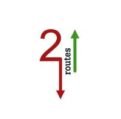Risk reward in forex refers to the relationship between the potential profit and potential loss on a trade, considering your entry point and stop-loss and take-profit levels. It’s a crucial concept for forex traders as it helps them manage risk and aim for profitability in the long run.
Here’s a breakdown of entry risk reward:
- Risk: This represents the maximum amount of money you’re willing to lose on a trade. It’s typically determined by placing a stop-loss order at a specific price level below your entry point (for long positions) or above your entry point (for short positions). The distance between your entry price and stop-loss price translates to your risk in pips.
- Reward: This represents the potential profit you aim to make on a trade. It’s usually determined by placing a take-profit order at a price level that aligns with your trading strategy and profit target. The distance between your entry price and take-profit price translates to your reward in pips.
- Risk-Reward Ratio: This ratio compares your potential reward to your potential risk, expressed as a number (e.g., 2:1, 3:1). Ideally, you want a higher reward than risk (ratio greater than 1) to achieve profitability over time, even if you don’t win every trade.
Why is Entry Risk Reward Important?
- Risk Management: By focusing on risk reward, you can ensure you’re not risking too much capital on a single trade. This helps you stay in the game even during losing streaks.
- Trading Discipline: It encourages discipline by requiring you to plan your entries, exits, and potential outcomes before initiating a trade.
- Profitability: Aimed-for risk-reward ratios greater than 1 help you achieve profitability over time, even with a win rate less than 50%, as long as your winning trades compensate for your losing ones.
How to Calculate Entry Risk Reward:
- Identify your stop-loss distance: This is the pip difference between your entry price and your stop-loss level.
- Identify your take-profit distance: This is the pip difference between your entry price and your take-profit level.
- Divide your take-profit distance by your stop-loss distance: This will give you your risk-reward ratio.
Example:
- You buy EUR/USD at 1.1000.
- You place a stop-loss at 1.0950 (50 pips below entry).
- You place a take-profit at 1.1050 (50 pips above entry).
- Risk-reward ratio: (Take-profit distance) / (Stop-loss distance) = 50 pips / 50 pips = 1:1
Remember:
- There’s no single “perfect” risk-reward ratio. It can vary depending on your trading strategy, risk tolerance, and market conditions.
- Beginner traders often target lower risk-reward ratios (around 1:1 or 1.5:1) to prioritize risk management.
- Experienced traders might aim for higher ratios (2:1 or 3:1) but with stricter trade selection and potentially lower win rates.
By understanding and implementing entry risk reward strategies, you can approach forex trading with a more calculated and potentially profitable approach.
